Non-residential building construction up by 5.6 percent
- Approved building permits during the second quarter of 2003 summed up to 23,557, representing a decrease of 7.5 percent compared with 25,459 approved building permits recorded over the same period of last year.
- An increase in applications over the same period of last year was observed for non-residential building construction. Approved building permits for non-residential building construction increased by 5.6 percent to 2,577 from 2,440. Those for residential building construction, on the other hand, went down by 6 percent from 18,030 to 16,956. Combined approved building permits for additions, alterations and repairs also exhibited a decrease of 19.3 percent to 4,024 from 4,989 approved building permits. Figure 1 compares the number of building permit applications by type of building for the second quarters of 2003 and 2002 (Table 1).
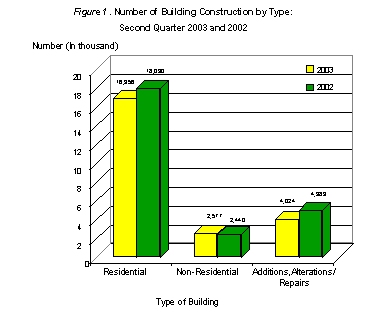
- For areas outside National Capital Region (NCR), three provinces registered approved building permits exceeding a thousand mark namely: Laguna (2,648), Cebu (1,471) and Cavite (1,382). Figure 2 for the regional distribution of approved building permits for the second quarter of 2003 (Table 1).
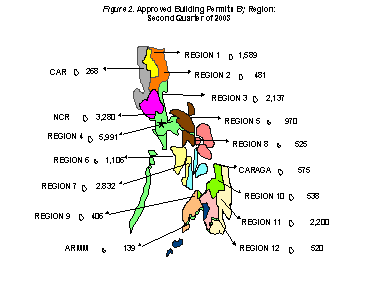
Value of constructions for non-residential buildings jumped by 41.2 percent
- Total value of construction during the second quarter of 2003 increased by 16.3 percent reaching P22.8 billion from P19.7 billion recorded during the same period of last year.
- Value of construction for residential buildings went up by 1.5 percent to P10.6 billion from P10.4 billion compared to the same quarter of 2002. On the other hand, value of construction for non-residential building significantly went up by 41.2 percent to P9.8 billion from P7.0 billion. Similarly, combined value for additions, alterations and repairs amounting to P2.5 billion posted an increase of 8.0 percent from P2.3 billion. Figure 3 compares the aggregate value of construction by type of building for the second quarters of 2003 and 2002.
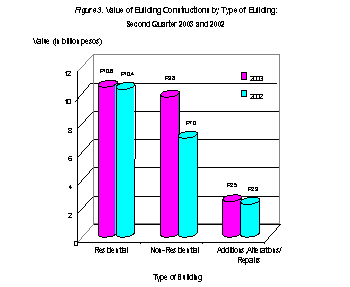
- Regionwise, value of construction in NCR remained highest at P10.0 billion, accounting for 43.9 percent of the total. Southern Tagalog and Central Luzon consistently occupied second and third spots with shares of 17.7 percent (P4.0 billion) and 6.8 percent (P1.6 billion), respectively, in terms of share to total value of construction.
Average cost per square meter of residential building construction is P4,953
- The total value of residential building construction was estimated at P10.6 billion with a total floor area of 2.1 million square meters or an average cost per square meter of P4,953.
- Comprising about 85.3 percent of the total approved building permits for residential building were applications for single type residential units. This type of construction numbered 14,461 approved building permits with a total floor area of 1.6 million square meters and an aggregate value of P8.0 billion. Approved building permits for apartment/accesoria and duplex/quadruplex reached 1,428 applications (8.4 percent) and 548 applications (3.2 percent), respectively. The least number for residential units was for "other residential construction" numbering 516 (3.0 percent) and residential condominium with only three (3) approved building permits during the period. Figure 4 shows the comparison of number and value of residential building construction during the second quarter of 2003 (Table 2).<
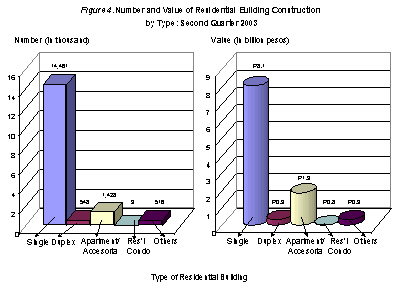
Average cost per square meter of non-residential building construction is P6,869
- Total value for non-residential building construction reached P9.8 billion during the second quarter of 2003 with a floor area of 1.4 million square meters. This translates to an average cost of P6,869 per square meter or 21.0 percent higher compared to the average cost of P5,676 per square meter during the same period of 2002.
- More than half or 56.1 percent of the total approved building permits for non-residential was for commercial buildings with 1,447 approved building permits valued at P6.6 billion. Institutional and industrial buildings recorded 485 approved building permits valued at P1.8 billion and 301 approved building permits valued at P941 million, respectively. Approved building permits for agricultural buildings numbered only 79 applications with an equivalent value of P85.9 million. Figure 5 shows the number and value of non-residential construction during the second quarter of 2003 (Table 3).
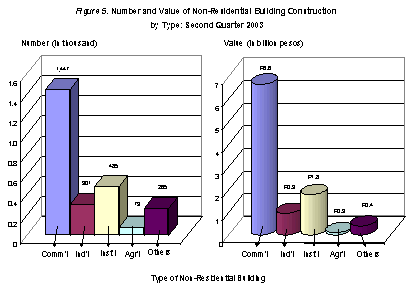
|
|
(Sgd.) CARMELITA N. ERICTA |
EXPLANATORY NOTES
Scope and Coverage:
Private construction statistics from approved building permits relate to data on new constructions and additions, alterations and repairs of residential and non-residential buildings and other structures undertaken in all regions/provinces of the country.
For second quarter of 2003, neither approved building permits nor certification of non-issuance of building permits were collected from Local Building Officials for the provinces of Lanao del Sur, Sulu and Tawi-Tawi.
Source of Information
Data are taken from the original application forms of approved building permits collected by NSO field personnel from local building officials nationwide
Limitations:
- Data on private building constructions refer to those proposed to be constructed or construction work started during the reference period and not to construction work completed during the reference period.
- The completeness of the number of building permits collected relies on the applications filed and approved by the Offices of Local Building Officials (LBOs). Hence, private building constructions without approved building permits are not included in the tabulation of data.
Definition of Terms:
Building Permit A written authorization granted by the Local Building Official (LBO) to an applicant allowing him to proceed with the construction of a specific project after plans, specifications and other pertinent documents have been found to be in conformity with the National Building Code (PD 1096).
Building Any independent, freestanding structure comprised of one or more rooms or other spaces, covered by a roof and enclosed with external walls or dividing walls, which extend the foundation to the roof.
Residential Building A building for which its major parts or more than half of its gross floor area is built for dwelling purposes. This type of building can be of the single type, duplex, an apartment and/or accessoria and residential condominium.
Single House A complete structure intended for a single family.
Duplex A structure intended for two households, with complete living facilities for each; it is a single structure divided into two dwelling units by a wall extending from the floor to the ceiling.
Apartment A structure, usually of two storeys, made up of independent living quarters, with independent entrances from internal walls and courts.
Accesoria A one or two-floor structure divided into several dwelling units, each dwelling unit having its own separate entrance from the outside.
Residential Condominium A structure, usually of several storeys, consisting of multiple dwelling units.
Other Residential Constructions Consist of school or company staff houses, living quarters for drivers and maids and guardhouses.
Non-Residential Building This type includes commercial, industrial, agricultural and institutional buildings.
Additions/Alterations and Repairs Construction works by which the utility of building or structure is raised or at least renewed or which materially extends the normal life of the building or structure.
Demolitions The systematic dismantling or destruction of a building/structure or in part.
Street Furniture’s These are street structures consisting of monuments, waiting sheds, benches, plant boxes, lampposts, electric poles and telephone poles.
Floor Area of Building The sum of the area of each floor of the building measured to the outer surface of the outer walls including the area of lobbies, cellars, elevator shafts and all communal spaces in multi-dwellings. Areas of balconies are excluded.
Total Value of Construction The sum of the cost of building, electrical, mechanical, plumbing and others. The value is derived from the approved building permit and represents the estimated value of the building or structure when completed.
Unpublished Data:
Unpublished data at the municipal level may also be made available upon request from the Industry Statistics Division, National Statistics Office, 4th Floor Solicarel II Ramon Magsaysay Boulevard, Sta. Mesa, Manila: Tel No. 716-39-32.
Source: National Statistics Office
Manila, Philippines
